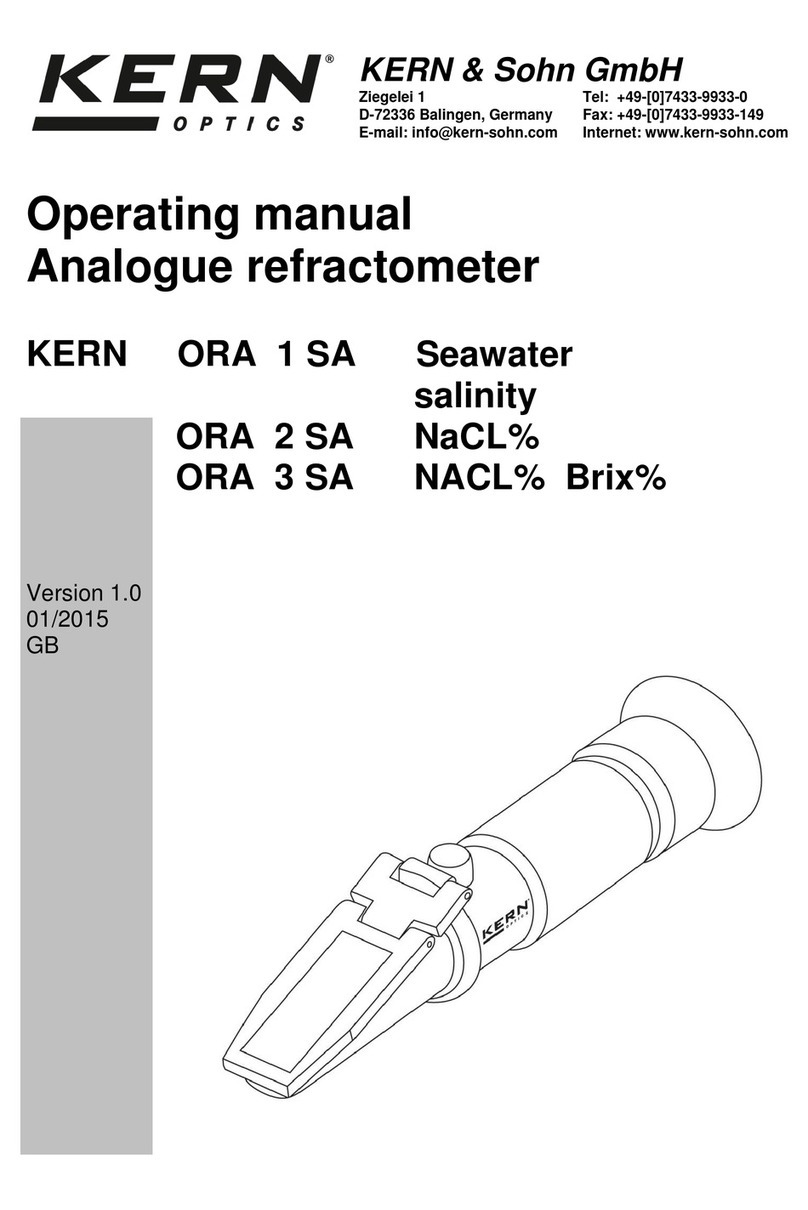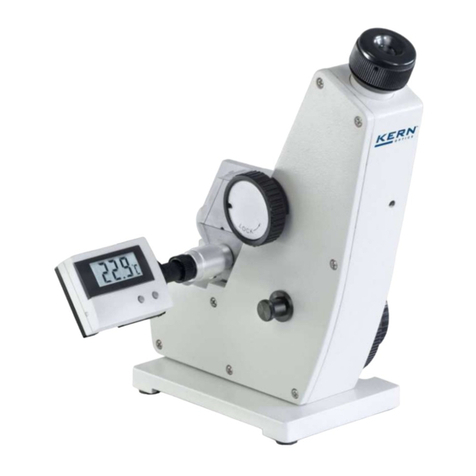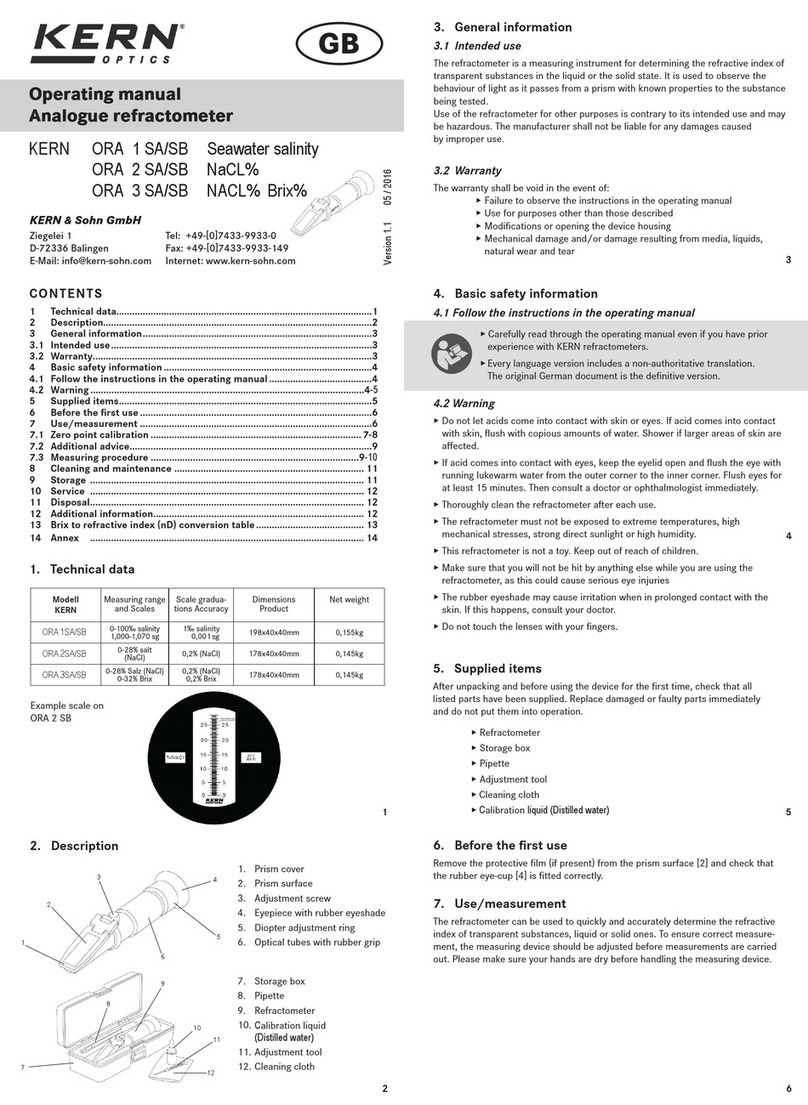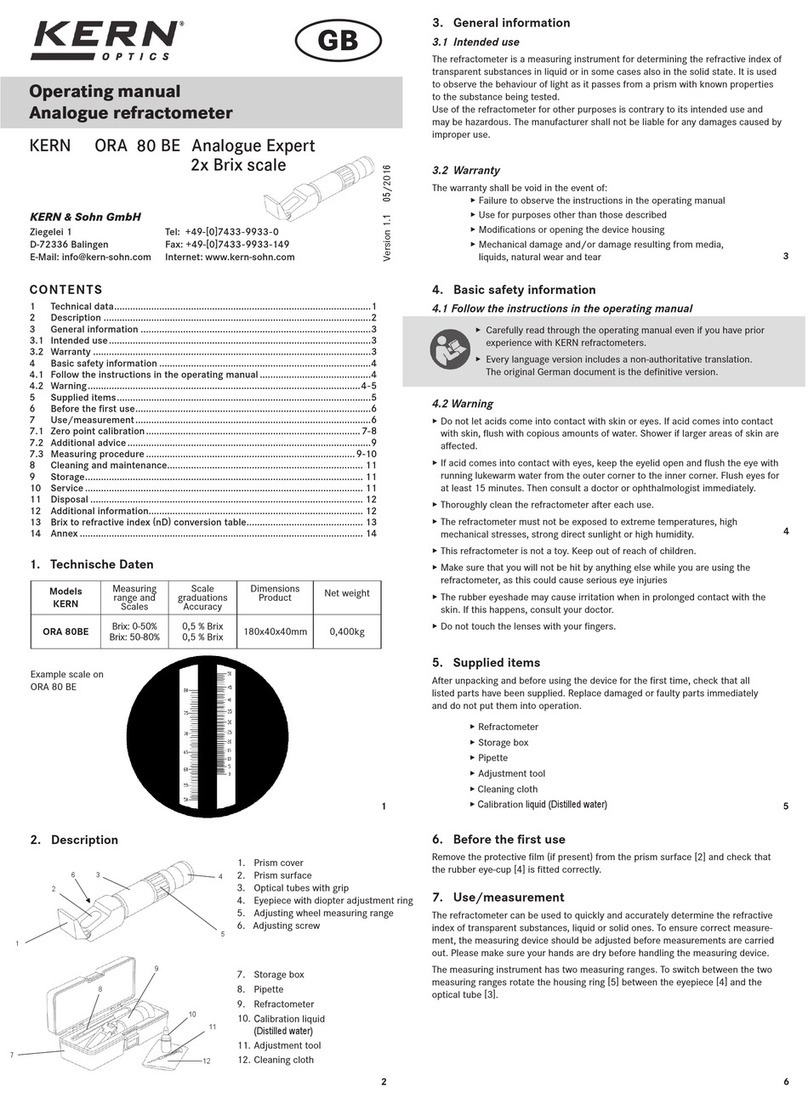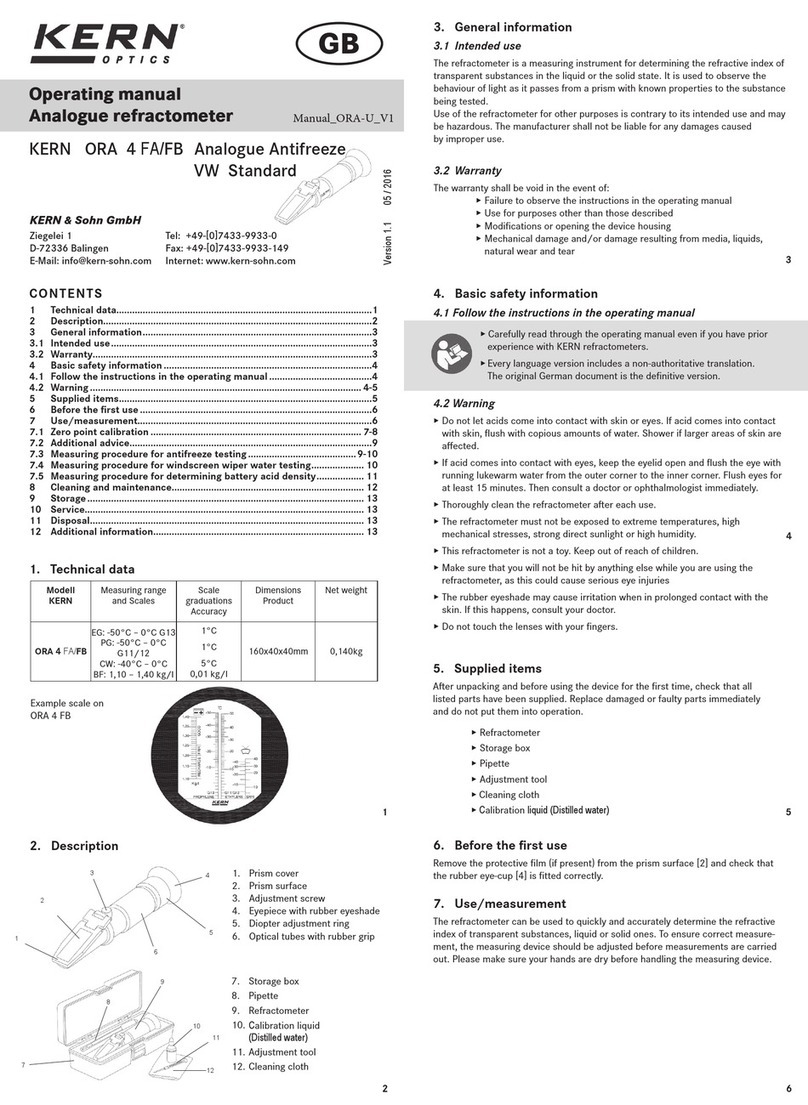
7
14
8
9
10
12
11
13
7. Use/measurement
▸ The refractometer can be used to quickly and accurately determine the refractive
index of transparent substances, liquid or solid ones. Please make sure your hands
are dry before handling the measuring device.
▸ The measuring instrument has three measuring ranges. Please use the measuring
range adjusting wheel on the underside of the casing to switch measuring ranges.
▸ The light falling on the prism can be changed using a rotating flap on the underside
of the prism.
▸ In addition, the refractometer is provided with an adjusting ring [4], which can
reduce chromating, primarily with low liquid concentrations.
▸ The light/dark transition is clearly visible.
Important!
The ambient/room temperature and the sample temperature influence
the refractometer measuring result.
The scales are designed for an ambient temperature of +20 °C!
If the measurements are carried out at a temperature other than +20 °C,
the results must be correspondingly corrected.
A correction table can be found in the annex, Point 14.
7.1 Additional advice
It is important that the samples being measured are representative samples.
Measurements should be carried out quickly on samples that evaporate easily. The
samples should be at the same temperature as the measuring instrument in order
to achieve an accurate result.
7.2 Measuring procedure
▸ Make sure your hands are dry before handling the refractometer.
▸ Open the prism cover [1]and use the supplied pipette [8]to apply a few drops of
the sample liquid [8]onto the prism surface [2], then close the prism cover [1].
Spread the liquid evenly by pressing down on the prism cover [1].
▸ Hold the device horizontally and wait about 30 seconds (for optimal temperature
equalisation between the sample and device).
▸ View the measurement scale through the eyepiece [6]. Point the prism surface [2]
of the refractometer at a bright light source while doing this.
▸ The light falling on the prism can be changed using a rotating flap on the
underside of the prism.
▸ Rotate the adjustment ring [6]on the eyepiece [6]to adjust the focus.
▸ The boundary line will move on the measurement scale depending on the concen-
tration. This bright/dark boundary line shows the result directly on the scale.
▸ The measuring instrument has three measuring ranges. Please use the measuring
range adjusting wheel on the underside of the casing to switch measuring ranges.
▸ The light/dark boundary can be brought into sharp focus using the dispersion
adjusting ring [6]. This is useful for low liquid concentrations.
▸ If the temperature deviates from +20 °C, correct the measured result using the
corresponding value from the temperature correction table (Point 14).
▸ Carefully clean the supplied pipette [8]and the refractometer aer carrying out
the measurement.
Important!
Aer every measurement, use a lint-free, absorbent cloth to remove
the fluids from the prism surface [2]and prism cover [1]. Then
carefully clean the prism and prism cover using a cloth moistened
with water or if necessary alcohol, and dry both parts using a so,
dry and lint-free cloth. Avoid rubbing the prism [2].
8. Cleaning and maintenance
Clean the refractometer using a so, lint-free cloth moistened with water, or if
necessary alcohol. Do not use any aggressive or abrasive cleaning agents. Never
immerse the device in water or hold it under running water. Never handle the device
with wet or damp hands.
Never touch the measuring prism [2]with hard tools made from plastic, wood,
rubber, metal, glass etc. Hard objects can quickly damage the relatively so prism
glass, resulting in measurement errors.
The refractometer is maintenance-free.
Cleaning should be carried out immediately before and aer each use of the
refractometer to maximise its life and optimise measurement results.
9. Storage
Store the refractometer in a dry, non-corrosive environment, preferably between
10°C and 30 °C.
9
10. Service
Aer reading this operating manual, if you have any questions about setting up or
using the refractometer, or if any unexpected problem occurs, please contact your
dealer. The device housing may only be opened by trained service technicians
authorised by KERN.
11. Disposal
The packaging consists of environmentally friendly materials which can be disposed
of via local recycling facilities.
The device and storage box should be disposed of by the operator in accordance
with applicable national or regional regulations at the place of use.
12. Additional information
The product may differ slightly from the illustrations.
Avoid exposing the refractometer to direct sunlight!
Never bring the refractometer into contact with solvents.
!
!
14. Annex
Table 1: International Temperature Correction Table for °Brix (% sugar gradient)
Correct the result by the following values (refractometer must be correctly
calibrated at 20 °C).
11 ORA_90BE-BA-e-1510
13 Brix to refractive index (nD) conversion table
BRIX
Refractive
indexBRIX
Refractive
indexBRIX
Refractive
index
% nD % nD%nD
0 1.33299301.38115601.44193
1 1.33442311.38296611.44420
2 1.33586321.38478621.44650
3 1.33732331.38661631.44881
4 1.33879341.38846641.45113
5 1.34026351.39032651.45348
6 1.34175361.39220661.45584
7 1.34325371.39409671.45822
8 1.34476381.39600681.46061
9 1.34629391.39792691.46303
101.34782401.39986701.46546
111.34937411.40181711.46792
121.35093421.40378721.47037
131.35250431.40576731.47285
151.35568451.40978751.47787
171.35891471.41385771.48295
181.36054481.41592781.48552
191.36218491.41799791.4881
201.36384501.42009801.49071
211.36551511.42220811.49333
221.36720521.42432821.49597
231.36889531.42647831.49862
241.37060541.42862841.50129
251.37233551.43080851.50398
261.37406561.43299
271.37582571.43520
281.37758581.43743
291.37936591.43967
Data from "ICUMSA" International Commission for Uniform Methods
of Sugar Analysis, at 20 °C and 589 nm wavelength.
Table 1: International TemperatureCorrectionTablefor °Brix(% sugar gradient)
Correct theresult by thefollowing values (refractometer must becorrectly calibrated at 20 °C)
% Brix
0.0 5.0 10.0 15.0 20.0 25.0 30.0 35.0 40.0 45.0 50.0 55.0 60.0 65.0 70.0 75.0 80.0 85.0
Temperature °C
10.0 -0.53 -0.56 -0.59 -0.62 -0.65 -0.67 -0.69 -0.71 -0.72 -0.73 -0.74 -0.75 -0.75 -0.75 -0.75 -0.75 -0.74 -0.73
11.0 -0.49 -0.52 -0.54 -0.57 -0.59 -0.61 -0.63 -0.64 -0.65 -0.66 -0.67 -0.68 -0.68 -0.68 -0.68 -0.67 -0.67 -0.66
-0.40 -0.41 -0.43 -0.45 -0.47 -0.48 -0.50 -0.51 -0.52 -0.52 -0.53 -0.53 -0.53 -0.53 -0.53 -0.53 -0.52 -0.52
14.0 -0.34 -0.36 -0.38 -0.39 -0.40 -0.42 -0.43 -0.44 -0.44 -0.45 -0.45 -0.46 -0.46 -0.46 -0.46 -0.45 -0.45 -0.44
-0.29 -0.31 -0.32 -0.33 -0.34 -0.35 -0.36 -0.37 -0.37 -0.38 -0.38 -0.38 -0.38 -0.38 -0.38 -0.38 -0.37 -0.37
-0.18 -0.19 -0.20 -0.20 -0.21 -0.21 -0.22 -0.22 -0.23 -0.23 -0.23 -0.23 -0.23 -0.23 -0.23 -0.23 -0.23 -0.22
18.0 -0.12 -0.13 -0.13 -0.14 -0.14 -0.14 -0.15 -0.15 -0.15 -0.15 -0.15 -0.15 -0.15 -0.15 -0.15 -0.15 -0.15 -0.15
-0.06 -0.06 -0.07 -0.07 -0.07 -0.07 -0.07 -0.08 -0.08 -0.08 -0.08 -0.08 -0.08 -0.08 -0.08 -0.08 -0.08 -0.07
0.06 0.07 0.07 0.07 0.07 0.07 0.08 0.08 0.08 0.08 0.08 0.08 0.08 0.08 0.08 0.08 0.08 0.07
22.0 0.13 0.14 0.14 0.14 0.15 0.15 0.15 0.15 0.16 0.16 0.16 0.16 0.16 0.16 0.15 0.15 0.15 0.15
0.20 0.21 0.21 0.22 0.22 0.23 0.23 0.23 0.23 0.24 0.24 0.24 0.24 0.23 0.23 0.23 0.23 0.22
25.0 0.34 0.35 0.36 0.37 0.38 0.38 0.39 0.39 0.40 0.40 0.40 0.40 0.40 0.39 0.39 0.39 0.38 0.37
26.0 0.42 0.43 0.44 0.45 0.46 0.46 0.47 0.47 0.48 0.48 0.48 0.48 0.48 0.47 0.47 0.46 0.46 0.46
0.50 0.51 0.52 0.53 0.54 0.55 0.55 0.56 0.56 0.56 0.56 0.56 0.56 0.55 0.55 0.54 0.53 0.52
0.66 0.67 0.68 0.69 0.70 0.71 0.72 0.73 0.73 0.73 0.73 0.73 0.72 0.72 0.71 0.70 0.69 0.68
30.0 0.74 0.75 0.77 0.78 0.79 0.80 0.81 0.81 0.81 0.82 0.81 0.81 0.81 0.80 0.79 0.78 0.77 0.75
13. Brix to refractive index (nD) conversion table
Data from „ICUMSA“ International Commission for Uniform Methods
of Sugar Analysis, at 20 °C and 589 nm wavelength.












